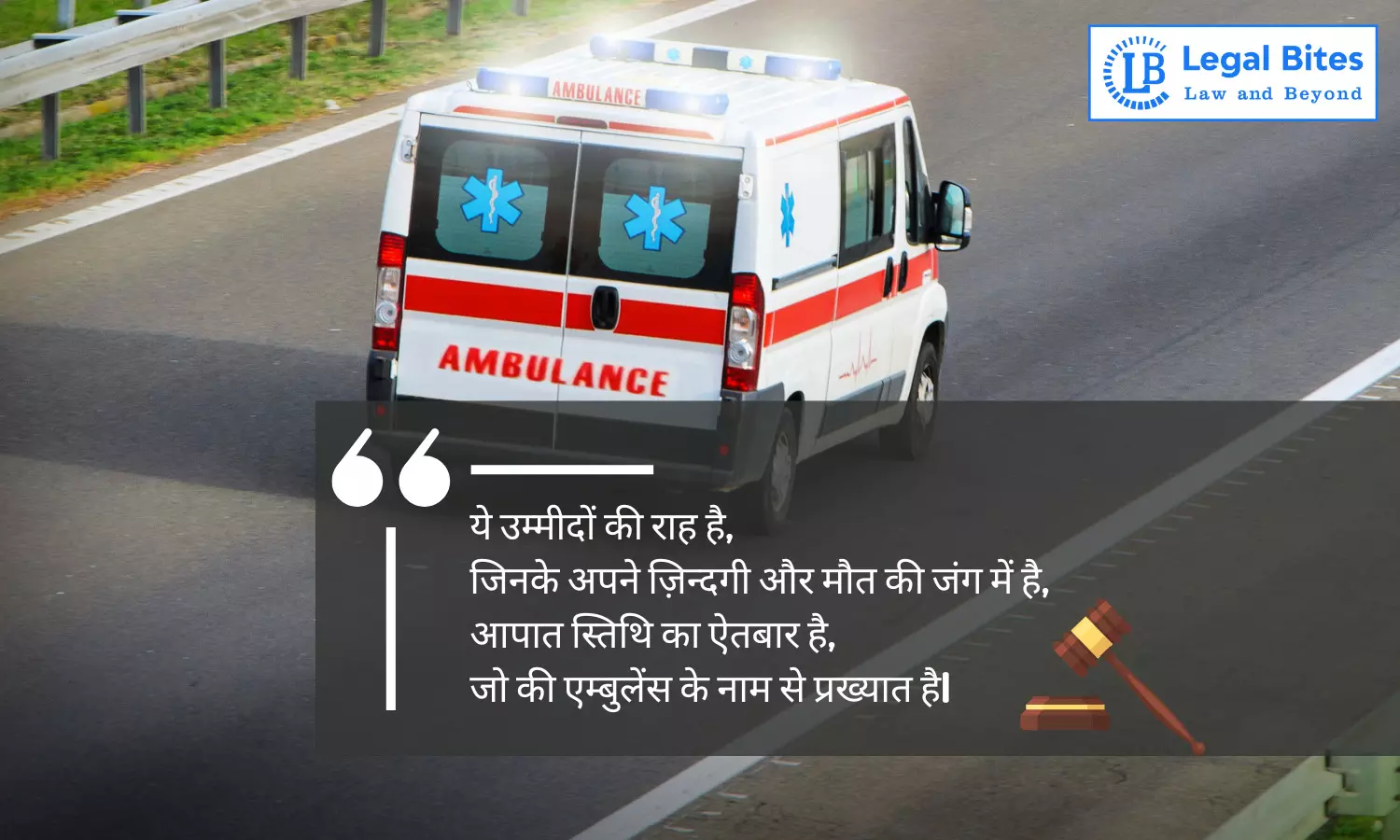Laws related to Ambulances in India
The Article 'Laws related to Ambulances in India' is a thorough study of the legislative protection assigned to ambulances designed to protect lives.

The Article 'Laws related to Ambulances in India' is a thorough study of the legislative protection assigned to ambulances designed to protect lives. The author deals with the concept of the ambulance and certain provisions of the Motor Vehicles Act, which prescribes punishment for obstructing ambulances. The facilities provided by ambulance service are very helpful in reaching hospitals on time, especially when the patient's situation becomes critical.
Introduction: AmbulanceLaws related to Ambulances
Whenever there is a medical emergency, we either take the patient to the hospital ourselves or rely on an ambulance. An ambulance is a vehicle that takes a patient to a medical healthcare facility or a hospital. When was the concept of ambulance introduced is a question which has many answers to it. Initially, the concept of an ambulance was not limited to a vehicle but also a human carrying the patient to the doctor, which was said to be an ambulance. An example can be an injured soldier being carried to military tents to get help from a medical professional. In the 19th Century, during the American Civil War, horse carriage was started to be used as Ambulances, then later, in 1912, horse-drawn ambulances were replaced by motor vehicles. In the 20th and 21st Centuries, emerging technologies were added in ambulances to facilitate patients' survival through the transportation process.
National Injury Surveillance Trauma Registry and Capacity Building Centre (NISC)
Trauma Injuries are one of the major public health issues globally, there are more deaths associated with trauma than malaria, tuberculosis, and HIV/AIDS combined together per year. In India, road accidents are increasing at an alarming rate of three per cent annually. A road accident is reported every three minutes and a death every ten minutes which amounts to the death of nearly 137,000 persons, three million hospitalizations, and 11 million minor accidents.
This has made the researchers emphasize strengthening the trauma system, which includes gathering and analyzing trauma data. Thereby taking steps to reduce the number of trauma cases. So, to take a step towards this and also to provide a comprehensive trauma care centre in India. The Government formulated the National Trauma Policy in 2005. It covered the following areas:
- Improving the healthcare system's infrastructure in rural areas
- Strengthening organizational aspects in English Trauma Systems
- Trauma Education / Interest Generation
- Rehabilitation
- Evaluation and Research
To cater to the need for a data management system, which would generate only authentic info on mortality data and on-road accident injuries, also on Injury Surveillance and hospital care is given to the trauma victims post the trauma happened. The NISC and Training Centre was established to coordinate the activities of all designated Trauma Centres that were established under the Trauma Scheme.
The NISC registers all the trauma/injury cases that are reported in the Dr. RML Hospital, New Delhi. The data collected is available for research and analysis. It helps in the evaluation and prevention, and can be used further to enhance quality control and injury prevention activities/schemes planning future research.
Definition of Ambulances
National Ambulance Code was set up by the Ministry of Road Transport and Highways (department of road transport and highways), The Government of India.
Road Ambulance or Ambulance is a specially equipped and ergonomically designed vehicle for transportation / emergent treatment of sick or injured people and capable of providing out-of-hospital medical care during transit / when stationary, commensurate with its designated level of care when appropriately staffed.
Types of Road Ambulances
There are four types of road ambulances. They are designated as follows based on the level of care they can provide:
1. Type A Road Ambulance /Medical First Responder Road Ambulance: It is designed to provide immediately out-of-hospital medical care to patients when the situation is stationary. This ambulance is any CMVR-approved Category M or L vehicle suitable for the terrain to be used but this kind of ambulance will not have the capability to transport patients in a supine state or provide them medical care inside the vehicle.
2. Type B Road Ambulance/ Patient Transport Vehicle Road ambulance: It is designed and equipped for the transport of patients who are not emergency patients and also not expected to become emergency patients.
3. Type C Road Ambulance/ Basic Life Support Ambulance: It is a vehicle ergonomically designed, and it is suitably equipped and appropriately staffed for the transport and treatment of patients who require non-invasive airway management / basic monitoring.
4. Type D Road Ambulance: Advanced Life Support Ambulance: It is a vehicle ergonomically designed and suitably equipped, and it is appropriately staffed for the transport and treatment of emergency patients requiring invasive airway management / intensive monitoring.
Role of the Bureau of Indian Standards (BIS)
The Bureau of Indian Standards (BIS) is the National Standard Body of India. It is responsible for the harmonious development of the activities of standardization, conformity assessment, quality certification of goods, marking, and for connected or incidental matters for the development of the industry and to meet the needs of the consumers.
Through its core activities, BIS has been benefiting the national economy by making available safe, good quality, and reliable goods, which in turn has also helped in minimizing health hazards to good consumers and also resulted in protecting the environment. To help the economy boom it has been promoting exports and imports substitutes, and it also plays a vital role in controlling the proliferation of varieties, etc. Its system of standardization aids in various public policies in areas of product safety, food safety, consumer and environment protection, building and construction, etc.
Quite recently, BIS worked towards addressing various national policies/priorities & also other government initiatives for example the Swachh Bharat Abhiyan (2014), Make in India (2014), Digital India (2015), and ease of doing business through its standardization and also its certification. In standards development (a process involving many individuals, companies, and governments to understand the advancement of standards by the adoption of emerging technologies), BIS addresses issues like environment and energy conservation, climate change, safety, facilitation of trade, and conditions of health. BIS is also determined towards making the process of conformity assessment much simpler and faster. There is a certain statutory framework on which BIS works.
Statutory Framework
The BIS is now governed by the Bureau of Indian Standards Act, 2016, which has been implemented since 12 October 2017. Some major highlights of the Act are:
- The Act categorized BIS as the National Standards Body.
- The Act allows multiple conformity assessment schemes that are in line with global practices.
- The Act enables the government to authorize any agency apart from BIS to certify and enforce conformity to a standard.
- The Act enables the government to include products under mandatory certification on the grounds of health, safety, national security, environment, and prevention of deceptive practices.
- The Act enables the government to bring the Hallmarking of precious metal articles under mandatory certification.
- The Act provides consumer protection measures for example the ban of non-conforming standard marked products, needed compensation to the consumer, and also more stringent penal provisions to give them a lesson.
The BIS runs on an organizational network to obtain its goals and objectives speedily and effectively, which is as follows:
BIS is Headquartered in New Delhi. In total it has 5 Regional Offices (ROs) located at Kolkata (Eastern India), Chennai (Southern India), Mumbai (Western India), Chandigarh (Northern India), and Delhi (Central India). Under the ROs there are the Branch Offices (BOs). In total there are thirty-three Branch Offices which are located at 28 different locations namely Ahmedabad, Bengaluru, Bhubaneswar, Bhopal, Chandigarh, Chennai, Coimbatore, Dehradun, Delhi, Durgapur, Faridabad, Ghaziabad, Guwahati, Hyderabad, Jaipur, Jammu, Jamshedpur, Kochi, Kolkata, Lucknow, Mumbai, Nagpur, Parwanoo, Patna, Pune, Raipur, Rajkot, and Vishakhapatnam. The Branch Offices serve as an effective link between State Governments, technical institutions, industries, consumers, etc., of that particular region in which the BO is situated.
To make the work of the BIS systematic, its activities are categorized under the following heads:
- Standards formulation
- International activities
- Product Certification
- Hallmarking
- Laboratory services
- Training services - National Institute of Training for Standardisation
- Consumer Affairs and Publicity
Conspicuity Code of the Ambulance
The Ambulance Conspicuity Code (Recognition) is given in Annexure 1 of the Ambulance Code. It has been split into six sections:
1. Colour: The basic colour of the van should be brilliant white, RAL code 9010. It should also sustain daily cleaning and washing and should be weather-resistant.
2. Conspicuity Improving Items (C2I): This includes all marking, striping, and symbols, and they should be brilliant red colour, RAL Code 3024. The Conspicuity items include:
- chevron patterns - red/silver and red/yellow,
- Battenburg patterns,
- "AMBULANCE" markings,
- the Star of Life,
- emergency number symbol.
- All "AMBULANCE" markings must follow a 7:1 ratio (length to height)
3. Emblems: Emblems are government/ private / operator signs, corporate identities (XXX) & any other sign, symbol, ambulance calling number marking, or striping that is not referred to in "Conspicuity Improving Items" section. Their size cannot be bigger than 60% of the word "AMBULANCE" marking.
4. Warning Lights: Type A and B Road Ambulances should have flashers fitted at appropriate locations as per the vehicle type. Type C and D Road Ambulances should have warning lights.
5. Sirens: The sirens on all ambulances shall be mounted on the front side of the vehicle. The sirens should be in accordance with IS 1884.
6. Recognition of personnel: Safety garments for ambulance personnel should conform to at least ISO 14116:2008.
Registration of Ambulances
Chapter IV of the Motor Vehicles, Act, of 1988, talks about the registration of vehicles, it states that no person shall drive a vehicle that is unregistered with the state registering authority in whose jurisdiction the place of residence or owner is. Section 53 states the grounds for suspension of registration such as its use in a public place would constitute a danger to the public, or that it fails to comply with the requirements of this Act or of the rules, or used for hire or reward without a valid permit for being used as such.
Different states have their own requirements for ambulance regulations. The Regional Transport Office shall have the details regarding the registration of ambulances in their area.
Punishment for those who obstruct ambulances
The 2019 amendment of the Motor Vehicles Act, of 1988 brought in the provision for punishment for obstructing emergency vehicles, so under section 194E, causing obstruction to an ambulance is punishable with imprisonment for six months and a fine up to 10 thousand rupees.
Conclusion
Nothing can be more important than saving the lives of people. So, the initiative for the transportation of patients since earlier times with the help of ambulances is a boon to the common people. We should not be in rush, in fact, allow ambulances to pass at first.
References
[1] History of Ambulance Services, Available Here
[2] History of Ambulance Services, Available Here
[3] National Ambulance Code, Available Here
[4] Bureau of Indian Standards, Available Here
[5] Laws Related to Ambulances in India, Available Here
[6] The Motor Vehicles Act, 1988, Available Here
Important Links
Law Library: Notes and Study Material for LLB, LLM, Judiciary, and Entrance Exams

